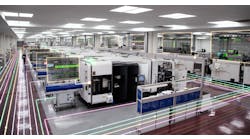Editor’s Note: This is the second in a series of analyses of the top 20 Computer Aided Machining software packages currently available. This month we examine GibbsCAM developed by Gibbs and Associates (www.gibbscam.com).
GibbsCAM is a single software product aimed at shops doing production work. The software is comprised of numerous modules that can be activated for a fee as a user needs them.
The software was originally developed in 1982, and underwent a complete rewrite in 1993 to provide a stronger architectural foundation for future development.
GibbsCAM pioneered the use of a graphical user interface. At the time of its release all other CAM software ran in some version of a Disk Operating System that was non-graphical text and command driven. This commitment to a graphical user interface has been the backbone of the product’s development and is the core environment where all work is done. Gibbs’ goal is to completely eliminate the need to manually edit G-code.
“The minute a user has to edit, work with or modify G-code he has gone back to the 1950s and needs to admit that his CAM package is not what it should be,” William Gibbs, president of Gibbs and Associates said.
“GibbsCAM is a toolpath creation product focused on fixing and machining the designs people send to machine shops for discrete parts. GibbsCAM strives to make software that through a well-designed graphical user interface we come up with an interactive intuitive software that people find easy to use and that solves their problems by letting them machine the parts fast and the way they want to machine those parts.”
Whether a piece of software is “easy to use” depends a lot on who is doing the using.
“If the user interface looks familiar or is intuitively understandable and the user can easily get the software to machine a part the way the user wants to machine it then it becomes “easy to use.” The concept of easy to use is so subjective that it becomes almost impossible to measure or quantify in a universally useful way. However there is some anecdotal evidence that can imply just how easy the software is to use.
According to William Gibbs, as many as 60 percent of the people who buy GibbsCAM do not buy training.
Instead, they rely on the manuals and tutorials provided with the software to become familiar with the product. In addition to training that can be purchased for the software, Gibbs and Associates also offers a tollfree, helpline to anyone who owns a copy of GibbsCAM. The helpline is free of charge, and operates workdays from 5:00 a.m. to 5:00 p.m. Pacific Standard Time.
Gibbs offers traditional classroom and on-site training through its reseller network and at its headquarters in Moorpark, Calif.
It also makes self-paced training courses available on video tape and CD.
“A lot of people just use the tutorials and are off and running,” Gibbs said.
“We can afford to offer a tollfree, no-cost helpline because we get so few calls. What we see is that a new user will call with a couple of questions the first week, maybe only one question the second week and then we rarely hear from them again. We’ve also begun to use online webinars this year. We’ve hosted two so far, and based on the response to those, we are excited about developing an extensive archive of recorded webinars. People can attend live and in real time or view them later,” he said.
One of the most important questions prospective buyers of CAM software ask is: “How quick and easy is it to learn to use the software efficiently?”
The fact that more than half of the new users of GibbsCAM feel no need to take formal classroom training is an indication that it is easy to learn to use the GibbsCAM software. With classroom, online and self-paced training available, Gibbs and its resellers now are offering a wide range of options to fit the needs of customers who want or need more formal training.
Other anecdotal evidence of how easy GibbsCAM is to learn to use includes the results of teaching GibbsCAM and another leading CAM package to two classes at a technical school near Gibbs’ headquarters.
“The instructor who teaches both classes told me that the difference on the final exam of an 18-week class between GibbsCAM and the other package was amazing,” Gibbs said.
“On the final, the group using GibbsCAM all finished their assigned task and left early while the group that was using the other package used all the time available and even then almost half of the students didn’t finish the programming task.”
Such comments need to be taken with a large grain of salt, especially since the instructor for both classes works for Gibbs and Associates as a technical engineer. However, it should be added that the instructor was working part time for the technical school and was subject to their review for competency.
Having a package that is intuitive to use is only one part of whether a package is easy to use or not. The other part is whether the package can actually machine a part the way the programmer wants to machine it, and that is something that has to be evaluated on a part-by-part basis.
“CAM products today are on a sliding scale of automation. At one extreme the software makes all the decisions and, at the other extreme, the user is doing manual programming,” Gibbs said.
“Machinists with anything more than just basic skills know what they want, know how they want to machine a part, and our job is to provide them the tool to achieve that.” GibbsCAM starts by requiring a lot of manual input, but enables users to easily automate as much or as little of the process as the user wants.
The ability to define and reuse machining processes is built into GibbsCAM. A user defines a method for machining a feature, and that definition is available automatically forever after. It may require 15 minutes to define a machining method the first time it is used, but after that, it only takes 15 seconds to recall it. This automatic reusability, along with automatic associativity has been an inherent part of GibbsCAM since it was developed.
Another special feature of GibbsCAM is that a user can work from geometry, surface or solid models without having to switch between modes.
According to Gibbs, the user can do anything at anytime — even change a model in the middle of machining a part based on that model. To facilitate this, Gibbs developed a sophisticated set of manufacturing focused CAD capabilities.
“We do not have a design CAD capability,” Gibbs said.
“Everything that does not generate a toolpath is a CAD function, and our customers need a lot of CA editing capability because of what the machinists are usually given. If the machinists can’t fix the files they are given, or repair the mistakes they find in those files, then they cannot machine the parts optimally. Our CAD function may look like a CAD system, but it is not a design package. It is a manufacturing focused package.”
GibbsCAM is a mature, feature-rich CAM package that is designed to meet the current and future needs of most production machine shops, but it needs to be tested by the shop’s programmers using typical parts that would be run on the shop’s machines. That last part — running programs created by a CAM package on specific machines — can be the difference between a given package becoming a “gotta have it” or a “waste of time looking at it.”
The key to running programs on a specific machine is the post processor that is used to convert the CAMgenerated toolpaths to G-code. Here, GibbsCAM offers a strong program of giving users exactly the post processor they need to avoid having to manually edit the G-code, and the company invests a lot of time and effort into making sure its customers have post processors that eliminate the need for manually editing G-code.
Gibbs offers a free post processor tool kit that is bundled into its software package for users who want to develop their own custom post processors. Gibbs also has a library of more than 8,000 proven post processors that can be purchased for just a few hundred dollars each. Gibbs charges only per post processor, not per seat.
If the user still needs a more customized post processor, Gibbs then will quote the costs of developing a post processor that will fit whatever machines and operations the user has.
Gibbs also spends more than half of its employee resources in enhancing and improving its software. Currently, 34 of the 64 employees at Gibbs and Associates are dedicated to product development. The company is committed to creating at least one major feature-rich release per year, while also releasing enhancements throughout the year. That dedication to on-going product development, along with the recent merger with Cimatron, is an indication that Gibbs will be around for a long time, and that its products will continue to evolve to fit the current and changing needs of its customers.
“Most of the software we sell today is replacing other CAM software.
The only way to know if our software is an appropriate choice is to first understand the problem the user is trying to solve. Once we identify that it becomes easy to see if we are a good fit or not,” Gibbs said.





